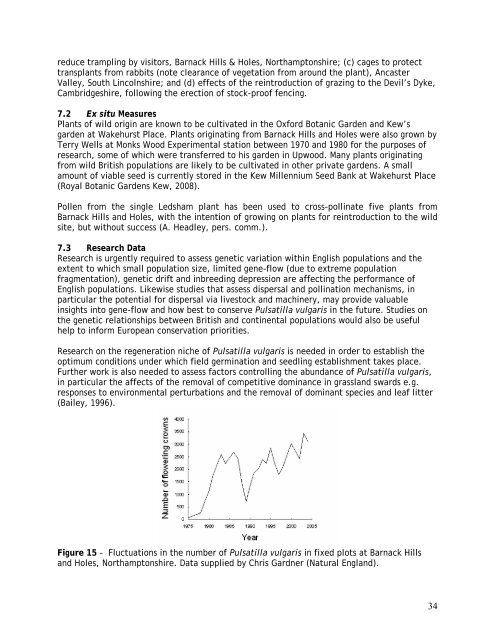Pulsatilla vulgaris (L.) Mill. - Plantlife
Pulsatilla vulgaris (L.) Mill. - Plantlife
Pulsatilla vulgaris (L.) Mill. - Plantlife
Create successful ePaper yourself
Turn your PDF publications into a flip-book with our unique Google optimized e-Paper software.
educe trampling by visitors, Barnack Hills & Holes, Northamptonshire; (c) cages to protect<br />
transplants from rabbits (note clearance of vegetation from around the plant), Ancaster<br />
Valley, South Lincolnshire; and (d) effects of the reintroduction of grazing to the Devil’s Dyke,<br />
Cambridgeshire, following the erection of stock-proof fencing.<br />
7.2 Ex situ Measures<br />
Plants of wild origin are known to be cultivated in the Oxford Botanic Garden and Kew’s<br />
garden at Wakehurst Place. Plants originating from Barnack Hills and Holes were also grown by<br />
Terry Wells at Monks Wood Experimental station between 1970 and 1980 for the purposes of<br />
research, some of which were transferred to his garden in Upwood. Many plants originating<br />
from wild British populations are likely to be cultivated in other private gardens. A small<br />
amount of viable seed is currently stored in the Kew <strong>Mill</strong>ennium Seed Bank at Wakehurst Place<br />
(Royal Botanic Gardens Kew, 2008).<br />
Pollen from the single Ledsham plant has been used to cross-pollinate five plants from<br />
Barnack Hills and Holes, with the intention of growing on plants for reintroduction to the wild<br />
site, but without success (A. Headley, pers. comm.).<br />
7.3 Research Data<br />
Research is urgently required to assess genetic variation within English populations and the<br />
extent to which small population size, limited gene-flow (due to extreme population<br />
fragmentation), genetic drift and inbreeding depression are affecting the performance of<br />
English populations. Likewise studies that assess dispersal and pollination mechanisms, in<br />
particular the potential for dispersal via livestock and machinery, may provide valuable<br />
insights into gene-flow and how best to conserve <strong>Pulsatilla</strong> <strong>vulgaris</strong> in the future. Studies on<br />
the genetic relationships between British and continental populations would also be useful<br />
help to inform European conservation priorities.<br />
Research on the regeneration niche of <strong>Pulsatilla</strong> <strong>vulgaris</strong> is needed in order to establish the<br />
optimum conditions under which field germination and seedling establishment takes place.<br />
Further work is also needed to assess factors controlling the abundance of <strong>Pulsatilla</strong> <strong>vulgaris</strong>,<br />
in particular the affects of the removal of competitive dominance in grassland swards e.g.<br />
responses to environmental perturbations and the removal of dominant species and leaf litter<br />
(Bailey, 1996).<br />
Figure 15 – Fluctuations in the number of <strong>Pulsatilla</strong> <strong>vulgaris</strong> in fixed plots at Barnack Hills<br />
and Holes, Northamptonshire. Data supplied by Chris Gardner (Natural England).<br />
34

















